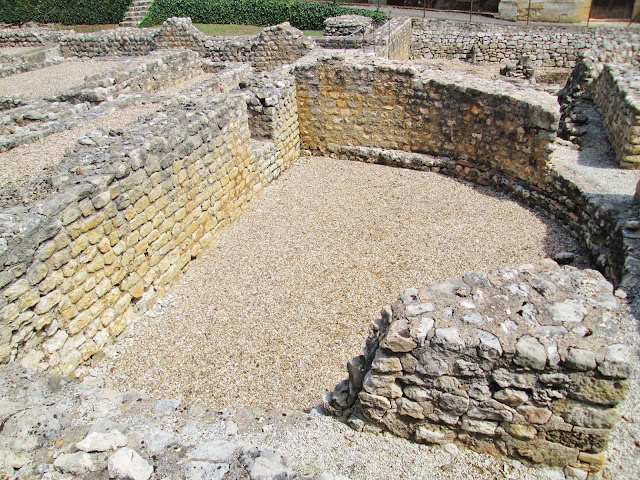I
have been following Mimi Thorisson’s blog, Manger, for a couple of years. Her
energy and style is amazing. In the last two years she and husband, Oddur, have
had another baby ( they have seven children all together between them - and nine dogs), bought a
large house in need of renovation, produced a cookbook, started giving cooking
classes , and now have opened what they refer to as a ‘pop up’ restaurant in
their home in the Médoc wine region northwest of Bordeaux. I told you Mimi has amazing energy.
 |
| 1 rue de Loudenne, Saint Yzans -de-Médoc |
So
this is the place I chose to celebrate my birthday this week. The restaurant is
only open on fifteen set dates through the summer for either lunch or dinner,
so you have to be quick for a reservation.
It’s
a two hour drive from our house so we took the opportunity for a little wander
around Pauillac on the way. This is one of the main towns in the Médoc and sits
beside the Gironde.
 |
| The pale stone of Médoc buildings in Pauillac |
 |
| how to draw attention to your wine shop |
 |
| A suitable welcome on the jetty at Pauillac |
It
was not far to the little hamlet of Saint Yzans-de-Médoc and the house wasn’t
difficult to find.
 |
| if you have the space, then why not a beautiful big dresser |
 |
| what a fabulous corner cupboard |
 |
| prep room |
 |
| busy in the kitchen |
 |
| If I'm very quiet perhaps they won't notice me watching them eat |
The
décor is casual french country style, and we shared a table with an English family
on holiday.
The
atmosphere was relaxed and friendly and Mimi and Oddur were very attentive.
They really know how to make you feel welcome.
 |
| simple table decoration |
The
food was excellent and their wine choices made for interesting discussions
about wines we have all tried from the region. The menu offers three courses with two choices for each, so naturally we ordered everything .
 |
| started with a glass of champagne and a platter of saucisson, radishes and bread |
 |
| gazpacho with garlic cream |
 |
krispy kale and garlic cream tartlet
|
So enthusiastic that I forgot to photograph our mains, a steak au poivre and a duck confit parmentier. Both delicious, of course.
For dessert we had chocolate meringue and walnut cake with a generous dousing of alcohol.
 |
| Oddur's photo of the chocolate meringue - very decadent |
 |
the walnut cake came with a birthday candle and Mimi and Oddur sang
'happy birthday' - sweet and thoughtful |
Graham's wine comments:
After starting with a Billecart-Salmon Brut Reserve champagne we were then introduced to a selection of local Medoc wines.
With our entree we tried two local Listrac white wines, basically both being a Sauvignon blanc but with a significant difference in nose and taste. Both were 2013 vintage, but the first had a strong "pear" taste and a dry palate. The second was more the standard Sav Blanc with a strong dry palate. Unfortunately, for the whites we did not take note of the producer so no guidance there.
Onto the main courses and we tried three different local 2010 north Haut-Medoc cabernets, starting with the lower grade wine and moving up to finish with a Grand Cru Classe Pauillac.
While the first rouge, was a basic local Saint-Estephe wine, we found it still a little heavy on the tannins and needing plenty of time to breathe. We then moved onto a Cru Bourgeois Saint Estephe, Chateau Mayne, which by comparison was more fully bodied with settled tannins and a broad black currant flavour.
Finally to finish, we tried the Grand Cru Classe Pauillac wine, Chateau Lynch-Moussas and this wine put the previous two into perspective. Lynch-Moussas was a relatively dark and soft, full bodied wine with subtle flavours of black currant. This vineyard is a neighbour of the well respected Chateau Lynch-Bages. Overall, the "smoothness" and flavours of this wine were clearly superior to the two earlier wines and the one that both Kerrie and I preferred.
Many
of the recipes are available in Mimi’s cookbook so it is well worth acquiring.
I have made her endive au jambon ( ham and endives) and her lemon and saffron ice cream. Both were easy to make and delicious.
And
her cookbook is called A Kitchen in France
 |
Oddur, Mimi, and little Audrey - apologies for the photo quality
but this was after a wonderful lunch and on our way out ! |
Mimi
and Oddur, if you decide to repeat the experience in other seasons, we would
love to return.
Bon chance with this enterprise.














































